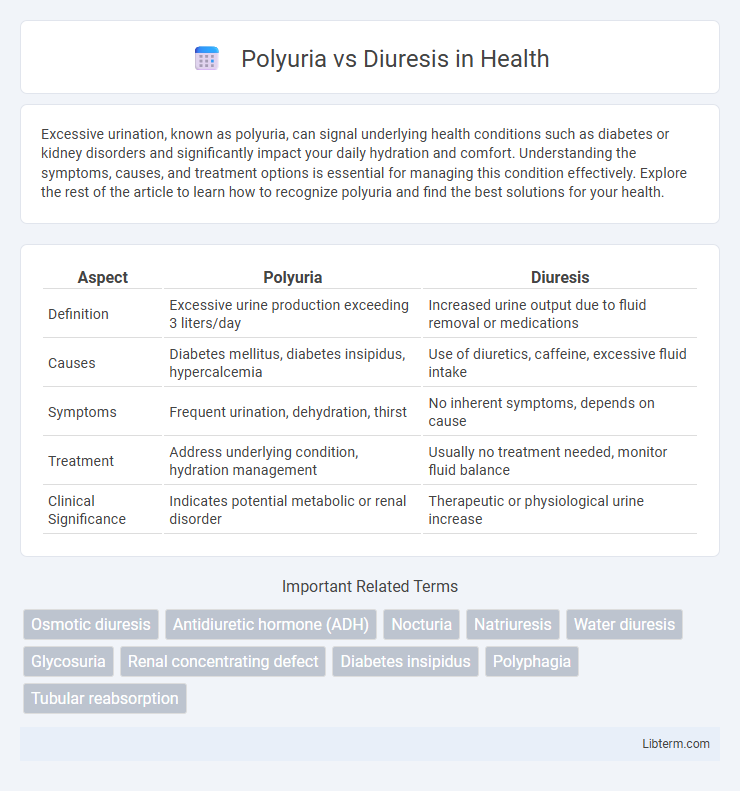Excessive urination, known as polyuria, can signal underlying health conditions such as diabetes or kidney disorders and significantly impact your daily hydration and comfort. Understanding the symptoms, causes, and treatment options is essential for managing this condition effectively. Explore the rest of the article to learn how to recognize polyuria and find the best solutions for your health.
Table of Comparison
| Aspect | Polyuria | Diuresis |
|---|---|---|
| Definition | Excessive urine production exceeding 3 liters/day | Increased urine output due to fluid removal or medications |
| Causes | Diabetes mellitus, diabetes insipidus, hypercalcemia | Use of diuretics, caffeine, excessive fluid intake |
| Symptoms | Frequent urination, dehydration, thirst | No inherent symptoms, depends on cause |
| Treatment | Address underlying condition, hydration management | Usually no treatment needed, monitor fluid balance |
| Clinical Significance | Indicates potential metabolic or renal disorder | Therapeutic or physiological urine increase |
Understanding Polyuria and Diuresis
Polyuria is characterized by an excessive production of urine, typically exceeding 3 liters per day, often linked to conditions such as diabetes mellitus or diabetes insipidus. Diuresis refers to an increased urine output triggered by factors like diuretic medications or fluid intake, serving as a physiological response to eliminate excess fluids. Differentiating polyuria from diuresis involves assessing underlying causes, urine volume, and electrolyte balance to guide appropriate clinical management.
Key Differences Between Polyuria and Diuresis
Polyuria is characterized by excessive urine production exceeding 3 liters per day, often due to underlying medical conditions like diabetes mellitus or diabetes insipidus, whereas diuresis refers to increased urine output caused by factors such as diuretics, fluid intake, or physiological responses. Polyuria involves abnormal urine volume as a symptom or disease manifestation, while diuresis is a controlled, often therapeutic increase in urine formation to remove excess fluids. The key difference lies in etiology and clinical implications: polyuria signals potential pathology with persistent high volume, whereas diuresis is typically a transient, regulated process induced for fluid balance.
Causes of Polyuria
Polyuria is characterized by excessive urine output exceeding 3 liters per day, commonly caused by uncontrolled diabetes mellitus, diabetes insipidus, and certain medications like diuretics. Diuresis refers to increased urine production due to physiological or pharmacological factors, often related to fluid intake or treatment of conditions such as hypertension and edema. Understanding the underlying causes of polyuria is essential for distinguishing it from diuresis and directing appropriate medical intervention.
Causes of Diuresis
Diuresis is caused by factors such as increased intake of fluids, use of diuretic medications, and certain medical conditions including diabetes mellitus and chronic kidney disease. It results from enhanced kidney filtration and reduced tubular reabsorption of water, leading to elevated urine production. Unlike polyuria, which is an excessive urine volume typically linked to pathological states, diuresis can be a physiological response to maintain fluid balance.
Common Symptoms and Clinical Presentation
Polyuria is characterized by excessive urine output often exceeding 3 liters per day, commonly associated with conditions like diabetes mellitus and diabetes insipidus, presenting symptoms such as increased thirst (polydipsia) and dehydration signs. Diuresis refers to increased urine production usually induced by diuretic medications or physiological responses, typically without significant electrolyte imbalance or dehydration unless prolonged. Clinical presentation of polyuria includes frequent urination and nocturia, while diuresis may be transient and less symptomatic unless it leads to volume depletion.
Diagnostic Approaches for Polyuria and Diuresis
Polyuria is characterized by excessive urine output exceeding 3 liters per day, often requiring diagnostic evaluation through urine osmolarity, blood glucose levels, and assessment of fluid intake to differentiate from diuresis, which involves increased urine production due to factors like diuretics or high fluid intake. Diagnostic approaches for polyuria include water deprivation tests to distinguish between diabetes insipidus and primary polydipsia, as well as measuring antidiuretic hormone (ADH) levels. Imaging studies and serum electrolyte analysis further aid in identifying underlying causes of polyuria, while diuresis diagnosis typically focuses on medication history and renal function tests.
Treatment Options for Polyuria
Treatment options for polyuria primarily aim to address the underlying cause, such as diabetes mellitus, diabetes insipidus, or medication side effects. Management strategies include optimizing blood glucose control with insulin or oral hypoglycemics for diabetes mellitus, desmopressin administration for central diabetes insipidus, and discontinuing or adjusting diuretic therapy if drug-induced polyuria is present. Adequate hydration and electrolyte monitoring are essential components of treatment to prevent dehydration and electrolyte imbalances.
Managing Diuresis: Strategies and Therapies
Managing diuresis involves targeted therapies such as diuretics, which promote fluid elimination to treat conditions like heart failure, hypertension, and edema. Strategies include careful monitoring of electrolyte balance, fluid intake, and renal function to prevent complications like dehydration or electrolyte imbalances. Personalized treatment plans optimize diuretic type and dosage, ensuring effective volume control while minimizing adverse effects.
When to Seek Medical Advice
Polyuria is characterized by excessive urine output exceeding 3 liters per day, often linked to conditions like diabetes mellitus or chronic kidney disease. Diuresis refers to increased urine production, which can be physiological, such as from diuretic medication or fluid intake. Seek medical advice if polyuria persists with symptoms like excessive thirst, weight loss, or changes in urination patterns, as it may indicate an underlying health issue requiring diagnosis and treatment.
Prevention and Lifestyle Modifications
Polyuria, characterized by excessive urine output typically exceeding 3 liters per day, differs from diuresis, which is the increased production of urine often induced by medications or physiological responses. Prevention of polyuria involves managing underlying conditions like diabetes mellitus through controlled blood glucose levels, while lifestyle modifications such as maintaining proper hydration, reducing caffeine and alcohol intake, and monitoring electrolyte balance help regulate urine production. Consistent medical follow-up and adapting a balanced diet rich in fiber and low in sodium are effective strategies to minimize symptoms and improve overall urinary health.
Polyuria Infographic

 libterm.com
libterm.com